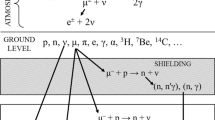Abstract
An irradiation facility consisting of a modified beam port shielding plug has been designed, fabricated built and characterized for use in irradiating non-standard sample geometries. The shielding plug features a graphite moderator at the core end with a hole, or “well” drilled of sufficient diameter and depth to accommodate an eight ounce (227 gram) sample bottle. Added shielding behind the graphite consists of castable neutron- and -gamma-ray shielding. The modified shielding plug can be removed relatively quickly from its irradiation position to minimize personnel exposures. It is mounted in close proximity to the Ohio State University Research Reactor reactor core to allow performance of high-sensitivity neutron activation analysis studies. Using the SAND-II unfolding code, the energy-dependent neutron flux has been measured in the sample irradiation position. When operating at 100 % power, the total flux is 3.9 × 1012 n/cm2/s. Of this, 55 % is thermal (<0.5 eV), 23 % is epithermal (>0.5 eV, <0.5 MeV), and 22 % is “fast” (>0.5 MeV). This makes the facility suitable for neutron activation studies. Recently it has been used for irradiation of filter papers collected in a study of particulate air pollution in the form of atmospheric particulate matter in an urban environment.






Similar content being viewed by others
References
Cao L, Landsberger S, Basunia S, Tao Yu (2004) Study of PM2.5 using neutron activation analysis and source appointment. J Radioanal Nucl Chem 1(261):87–94
Cao L, Tian WZ, Ni BF (2002) Preliminary study of airborne particulate matter in a Beijing sampling station using instrumental neutron activation analysis. Atmos Environ 12(36):1951–1956 (IF: 3.226)
The Ohio State University Research Reactor Technical Specifications, USNRC Docket 50-150, License R-75, December, 1999
McElroy WN, Berg S, Crockett T, Hawkins RG (1967) “A computer-automated iterative method for neutron flux spectra determination by foil activation, vol I: A study of the iterative method,” AFWL-TR-67, Defence Technical Information Center, Fort Belvoir
Berg S, McElroy WN (1967) “A computer-automated iterative method for neutron flux spectra determination by foil activation, vol II: SAND II (spectrum analysis by neutron detectors II) and associated codes,” AFWL-TR-67-41, Defence Technical Information Center, Fort Belvoir
McElroy WN, Berg S (1967) “A computer-automated iterative method for neutron flux spectra determination by foil activation, vol IV: Reference spectrum library for SAND II,” AFWL-TR-67-41, Defence Technical Information Center, Fort Belvoir
Berg S (1968) “Modification of SAND II,” BNWL-855, Pacific Northwest Laboratory, Richland
Author information
Authors and Affiliations
Corresponding author
Rights and permissions
About this article
Cite this article
Talnagi, J.W., Glover, S.E., Spitz, H. et al. Fabrication and characterization of an irradiation facility for large-sample geometry. J Radioanal Nucl Chem 296, 83–88 (2013). https://doi.org/10.1007/s10967-012-2073-7
Received:
Published:
Issue Date:
DOI: https://doi.org/10.1007/s10967-012-2073-7




